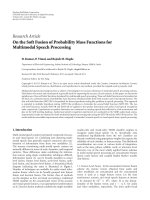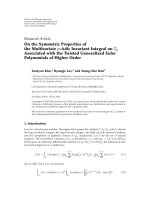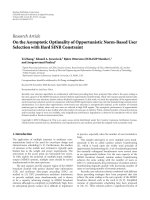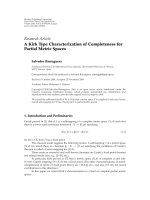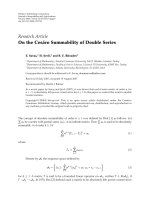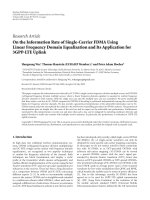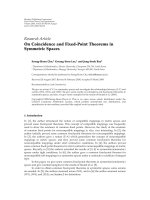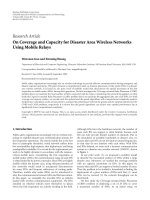Báo cáo hóa học: " Research Article On Complex Oscillation Property of Solutions for Higher-Order Periodic Differential Equations Zong-Xuan Chen and Shi-An Gao" pdf
Bạn đang xem bản rút gọn của tài liệu. Xem và tải ngay bản đầy đủ của tài liệu tại đây (554.5 KB, 13 trang )
Hindawi Publishing Corporation
Journal of Inequalities and Applications
Volume 2007, Article ID 58189, 13 pages
doi:10.1155/2007/58189
Research Article
On Complex Oscillation Property of Solutions for
Higher-Order Periodic Differential Equations
Zong-Xuan Chen and Shi-An Gao
Received 13 March 2007; Accepted 21 June 2007
Recommended by Patricia J. Y. Wong
We investigate properties of the zeros of solutions for higher-order per iodic differential
equations, and prove t hat under certain hypotheses, the convergence exponent of zeros
of the product of two linearly independent solutions is infinite.
Copyright © 2007 Z X. Chen and S A. Gao. This is an open access article distributed
under the Creative Commons Attribution License, which p ermits unrestricted use, dis-
tribution, and reproduction in any medium, provided the original work is properly cited.
1. Introduction and results
Consider the zeros of solutions of linear differential equations with periodic coefficients,
for the second-order equation
f
+ A(z) f = 0, (1.1)
where A is entire and nonconstant with period ω; a number of results have been obtained
in [1, 2]. For the higher-order differential equation
f
(k)
+ A
k−2
f
(k−2)
+ ···+ A
0
f = 0. (1.2)
Bank and Langley proved the following theorems in [3].
Theorem 1.1. Let k
≥ 2 be an integer, A
0
, ,A
k−2
be entire periodic functions with pe riod
2πi, such that A
0
is transcendental in e
z
with
lim
r→∞
loglogM
r,A
0
r
= c<
1
2
, (1.3)
2 Journal of Inequalities and Applications
and for each j with 1
≤ j ≤ k − 2, the coefficient A
j
either is rational in e
z
or satisfies
lim
r→∞
loglogM
r,A
j
r
<c. (1.4)
Then (1.2) cannot have linearly independent solutions f
1
, f
2
satisfying
log
+
N
r,
1
f
1
f
2
=
O(r). (1.5)
Theorem 1.2. Suppose that k
≥ 2 and A
0
, ,A
k−2
are entire functions of period 2πi,and
that f is a nontrivial solution of a differential equation (1.2). Suppose further that f satisfies
log
+
N
r,
1
f
=
o(r), (1.6)
A
0
is nonconstant and rational in e
z
,andifk ≥ 3 then A
1
, ,A
k−2
are constants. The n there
exists an inte ger q with 1
≤ q ≤ k, such that f (z) and f (z + q2πi) are linearly dependent.
The same conclusion holds if A
0
is transcendental in e
z
and f satisfies
log
+
N
r,
1
f
=
O(r), (1.7)
and if k
≥ 3, then as r → +∞ through a set L
1
of infinite linear measure, we have
T
r,A
j
=
o
T
r,A
0
( j = 1, , k − 2). (1.8)
In this paper, we will assume that the reader is familiar w ith the fundamental results
and the standard notations of Nevanlinna’s value distribution theory of meromorphic
functions (e.g., see [4, 5]). In addition, we will use σ( f )andμ( f ) to denote, respectively,
the order and t he lower order of meromorphic function f (z), λ( f ) to denote the conver-
gence exponent of zeros of f (z).
Let A(z) be an entire function. We define
σ
e
(A) = lim
r→∞
logT(r,A)
r
(1.9)
to be the e-type order of A(z). Clearly,
σ
e
(A) = lim
r→∞
loglogM(r,A)
r
. (1.10)
ThemainaimofthispaperistoimprovetheresultofTheorem 1.1. In the following
theorem (Theorem 1.3), we weaken the conditions (1.3)and(1.4)ofTheorem 1.1.Inpar-
ticular, in Corollary 1.4, the condition σ(G
0
) < 1/2, σ(g
j
) < max{σ(G
0
), σ(g
0
)},isweaker
than that of Theorem 1.1,byRemark 2.3, we see that this condition in Corollary 1.4
shows that σ
e
(A
0
) may be arbitrary, that is, in Corollary 1.4, the restriction “c<1/2” of
Theorem 1.1 is redundant. Thus, Theorem 1.3 and Corollary 1.4 improve essentially the
result of Theorem 1.1.
Z X. Chen and S A. Gao 3
The other aim of this paper is to consider what condition will guarantee that every
solution f
≡ 0of(1.2) satisfies λ( f ) =∞.InTheorem 1.6 and Corollaries 1.7 and 1.8,
we prove that under certain hypotheses, every solution f (
≡ 0) of (1.2) satisfies (1.14), so
λ( f )
=∞.
Theorem 1.3. Let k
≥ 2 and A
j
(z) = B
j
(e
z
) = B
j
(ζ), ζ = e
z
, B
j
(ζ) = G
j
(ζ)+g
j
(1/ζ), j =
0,1, ,k − 2,whereG
j
(t) and g
j
(t) are entire functions. Suppose the following:
(i) G
0
(t) is transcendental and σ(G
0
) < ∞ if σ(G
0
) > 0, then G
0
also satisfies that for
any τ satisfying 0 <τ<σ(G
0
), there exists a subset H ⊂ (1, +∞) with infinite loga-
rithmic measure, such that when
|t|=r ∈ H,
log
G
0
(t)
>r
τ
; (1.11)
(ii) for j>0, G
j
(t) either is a polynomial or σ(G
j
) <σ(G
0
);
(iii) for j>0,g
j
(t) either is a polynomial or σ(g
j
) < max{σ(G
0
), σ(g
0
)},whereg
0
(t) is
arbitrary entire function.
Then (1.2) cannot have linearly independent solutions f
1
, f
2
satisfying (1.5).
The same conclusion remains valid if G
j
(t) and g
j
(t)(j = 0, ,k − 2) are transposed in
the hypotheses (i)–(iii) above.
Corollary 1.4. Let k
≥ 2 and A
j
(z) = B
j
(e
z
) = B
j
(ζ), ζ = e
z
, B
j
(ζ) = G
j
(ζ)+g
j
(1/ζ),
j
= 0,1, ,k − 2,whereG
j
(t) and g
j
(t) are entire functions. Suppose the following:
(i)
∗
G
0
(t) is transcendental with σ(G
0
) < 1/2;
(ii)
∗
for j>0,G
j
(t) either is a polynomial or σ(G
j
) <σ(G
0
);
(iii)
∗
for j>0,g
j
(t) either is a polynomial or σ(g
j
) < max{σ(G
0
), σ(g
0
)}.
Then (1.2) cannot have linearly independent solutions f
1
, f
2
satisfying (1.5).
The same conclusion remains valid if G
j
(t) and g
j
(t)(j = 0, ,k − 2) are transposed in
the hypotheses (i)
∗
–(iii)
∗
above.
We introduce the concept of gap power series before we state Corollary 1.5.Anentire
function f is said to be a gap power series if f (z)
=
∞
n=0
a
n
z
λ
n
,where{λ
n
} is a increasing
sequence of positive integers, f is said to have a Fabry gap if
lim
n→∞
n
λ
n
= 0. (1.12)
Corollary 1.5. Assume that the hypotheses of Corollary 1.4 are satisfied but the statements
(i)
∗
and (ii)
∗
are replaced, respectively, by the following:
(i)
∗∗
G
0
(t) is an entire function with Fabry g ap with σ(G
0
) < +∞;
(ii)
∗∗
for j>0, eithe r G
j
(t) is a polynomial or σ(G
j
) <μ(G
0
).
Then the conclusion of Corollary 1.4 remains valid.
Theorem 1.6. Let k
≥ 2 and A
j
(z) = B
j
(e
z
) = B
j
(ζ), ζ = e
z
, B
j
(ζ) = G
j
(ζ)+g
j
(1/ζ), j =
0,1, ,k − 2,whereG
j
(t) and g
j
(t) are entire functions. Suppose the following:
(1) g
0
(t) is transcendental and σ(g
0
) < ∞,ifσ(g
0
) > 0,thenforanyτ satisfying 0 <
τ<σ(g
0
), there exists a subset H ⊂ (1,+∞) with infinite logarithmic measure, such
that when
|t|=r ∈ H,
log
g
0
(t)
>r
τ
; (1.13)
4 Journal of Inequalities and Applications
(2) for j>0, either g
j
(t) is a polynomial or σ(g
j
) <σ(g
0
);
(3) for j
≥ 0,G
j
(t) is polynomial of degree p
j
such that 0 ≤ p
s
< min{k − s, p
0
} (s =
1, ,k − 2) and p
0
is not divisible by k.
Then every nontrivial solution f of (1.2)musthaveλ( f )
=∞, and in fact, the stronger
conclusion
log
+
N
r,
1
f
=
o(r)(r −→ ∞ ) (1.14)
holds.
The same conclusion remains valid if G
j
(t) and g
j
(t)(j = 0, ,k − 2) are transposed in
the hypotheses (1)–(3) above.
Corollary 1.7. Let k
≥ 2 and A
j
(z) = B
j
(e
z
) = B
j
(ζ), ζ = e
z
, B
j
(ζ) = G
j
(ζ)+g
j
(1/ζ),
j
= 0,1, ,k − 2,whereG
j
(t) and g
j
(t) are entire functions. Suppose the following:
(1)
∗
g
0
(t) is transcendental and σ(g
0
) < 1/2;
(2)
∗
for j>0, eithe r g
j
(t) is a polynomial or σ(g
j
) <σ(g
0
);
(3)
∗
for j ≥ 0, G
j
(t) is a polynomial of degree p
j
such that 0 ≤ p
s
< min{k − s, p
0
} (s =
1, ,k − 2) and p
0
is not divisible by k.
Then every nontrivial solution f of (1.2)musthaveλ( f )
=∞, and in fact, the stronger
conclusion (1.14) holds.
The same conclusion remains valid if G
j
(t) and g
j
(t)(j = 0, ,k − 2) are transposed in
the hypotheses (1)
∗
–(3)
∗
above.
Corollary 1.8. Assume that the hypotheses of Corollary 1.7 are satisfied but the statements
(1)
∗
and (2)
∗
are replaced, respectively, by the following:
(1)
∗∗
G
0
(t) is an entire function with Fabry g ap with σ(G
0
) < +∞;
(2)
∗∗
for j>0, eithe r G
j
(t) is a polynomial or σ(G
j
) <μ(G
0
).
Then the conclusion of Corollary 1.7 remains valid.
2. Lemmas for the proof of Theorem 1.3
Lemma 2.1 (see [6]). Let f be a transcendental meromor phic function with σ( f )
= σ<∞.
Let H
={(k
1
, j
1
),(k
2
, j
2
), ,(k
q
, j
q
)} be a finite set of distinct pairs of integers that satisfy
k
i
>j
i
≥ 0 for i = 1, ,q.Alsoletε>0 be a given constant. Then there exists a set E
1
⊂
(1,∞) with finite logarithmic measure such that for all z satis fying |z| /∈ [0, 1] ∪ E and for
all (k, j)
∈ H one has
f
(k)
(z)
f
(j)
(z)
≤|
z|
(k− j)(σ−1+ε)
. (2.1)
Remark 2.2. Let g(ζ) be a function analytic in R
0
< |ζ| < ∞.By[7, page 15], g(ζ)canbe
represented as
g(ζ)
= ζ
m
ψ(ζ)F(ζ), (2.2)
Z X. Chen and S A. Gao 5
where ψ(ζ) is analytic and does not vanish in R
0
< |ζ|≤∞and ψ(∞) = 1, F is an entire
function and
F(ζ)
= u(ζ)e
h(ζ)
, (2.3)
where the function u(ζ) is a Weierstrass product formed by the zeros of g(ζ)inR
0
< |ζ| <
∞, h(ζ) is an entire function. If u(ζ)isoffiniteorderofgrowth,setW(ζ) = ψ(ζ)u(ζ),
since as ζ
→∞, ψ
(j)
(ζ)/ψ(ζ) = o(1), by Lemma 2.1, it is easy to see that there exists a
subset E
1
⊂ (0,∞) having finite logarithmic measure and a constant M
1
(> 0), such that
for all ζ satisfying
|ζ| ∈ E
1
,
W
(j)
(ζ)
W(ζ)
≤|
ζ|
M
1
. (2.4)
Remark 2.3. By [8, page 276], we know that if A(z) is an entire function and A(z)
=
B(e
z
) = B(ζ) = G(ζ)+g(1/ζ), where G(t)andg(t) are entire functions, then
σ
e
(A) = max
σ(G),σ(g)
. (2.5)
Lemma 2.4 (see [3]). Let A(z) be a nonconstant entire function with period 2πi. Then
c
= lim
r→∞
T(r,A)
r
> 0. (2.6)
If c is finite, then A(z) is rational in e
z
.
We easily prove the following lemma.
Lemma 2.5. Let A
j
(z)(j = 1,2) be entire functions with A
j
(z) = B
j
(e
z
) = B
j
(t), t = e
z
.If
B
1
(t) is transcendental (i.e., Laurent’s expansion of B
1
(t) is of infinitely many terms) and
B
2
(t) is rational, then
T
r,A
2
=
o
T
r,A
1
. (2.7)
Lemma 2.6. Suppose that A
j
, B
j
, G
j
, g
j
( j = 0, ,k − 2) satisfy the hypotheses of Theorem
1.3.If f (z)(
≡ 0) is a solution of (1.2)andsatisfies(1.7), then in 1 < |ξ| < ∞, f (z) can be
represented as
f (z) = ξ
d
ψ(ξ)u(ξ)e
h(ξ)
, (2.8)
where ξ
= e
z/q
, q is an integer and satisfies 1 ≤ q ≤ k, d is some constant, ψ(ξ) is analytic
and does not vanish in 1 <
|ξ|≤∞and ψ(∞) = 1,bothu(ξ) and h(ξ) are entire functions
of finite order.
If G
j
(t) and g
j
(t)(j = 0, ,k − 2) are transposed in (i)–(iii), then the same conclusion
still holds with ξ
= e
−z/q
.
Proof. By Remark 2.3 we see that
σ
e
A
j
=
max
σ
G
j
, σ
g
j
. (2.9)
6 Journal of Inequalities and Applications
By the hypotheses (i)–(iii) of Theorem 1.3, we easily see that if σ
e
(A
0
) > 0, then there
exists a set H
⊂ (0,∞) of infinite linear measure, such that
T
r,A
j
=
o
T
r,A
0
, r ∈ H; (2.10)
if σ
e
(A
0
) = 0, then by Lemma 2.5,
T
r,A
j
=
o
T
r,A
0
( j = 1, , k − 2). (2.11)
Now suppose that f (
≡ 0) is solution of (1.2) and satisfies (1.7). By (2.10), (2.11), and
Theorem 1.2, we see that there exists an integer q :1
≤ q ≤ k such that f (z)and f (z +
q2πi) are linearly dependent. By [9, page 382], we see that f (z)canberepresentedas
f (z)
= e
d
1
z
G
e
z/q
, (2.12)
where G(ξ)isanalyticin0<
|ξ| < ∞, ξ = e
z/q
.ByRemark 2.2,weseethatin1< |ξ| < ∞,
G(ξ)mayberepresentedas
G(ξ)
= ξ
m
ψ(ξ)u(ξ)e
h(ξ)
, (2.13)
where m is an integer, ψ(ξ) is analytic and does not vanish in 1 <
|ξ|≤∞and ψ(∞) = 1,
u(ξ) is a Weierstrass product formed by the zeros of G(ξ)in1<
|ξ| < ∞, h(ξ)isanentire
function, hence (2.8)holds.
Firstly, we prove that u(ξ) is of finite order of growth. By the transformation ξ
= e
z/q
and (1.7), the counting function N
1
(ρ,1/G)ofG(ξ)in1< |ξ| < ∞ satisfies log
+
N
1
(ρ,1/G)
= O(logρ). So that u(ξ) is an entire function of finite order.
Secondly, we prove that h(ξ)isoffiniteorderofgrowth.SetW(ξ)
= ψ(ξ)u(ξ), then
f (z)
= ξ
d
W(ξ)e
h(ξ)
. (2.14)
Substituting (2.14)into(1.2), we obtain
(h
)
k
+ P
k−1
(h
) = 0, (2.15)
where P
k−1
(h
)isadifferential polynomial in h
of total degree k − 1, its coefficients are
polynomials in W
(s)
/W (s = 1, ,k), 1ξ
m
(m = 1, ,k − 1), A
j
(z)(j = 0, ,k − 2).
By Remark 2.2, we see that there exists a subset E
1
⊂ (0, ∞) with finite logarithmic
measure and a constant M
1
, such that for all ξ satisfying |ξ| ∈ E
1
,andfors = 1, ,k,
m
= 1, ,k − 1,
1
ξ
m
W
(s)
(ξ)
W(ξ)
≤|
ξ|
M
1
. (2.16)
By (2.15)and(2.16), we obtain
m(ρ,h
) ≤ M
m
ρ,G
0
ξ
q
+logm(ρ,h
)+logρ
, (2.17)
where ρ
∈ E
2
, E
2
⊂ [0, ∞) is a set of finite linear measure, M(> 0) is a constant. Since
G
0
(t)isoffiniteorder,by(2.17), we see that h(ξ)isoffiniteorder.
Z X. Chen and S A. Gao 7
If G
j
(t)andg
j
(t)(j = 0, , k − 2) are transposed in (i)–(iii), we can still deduce the
same conclusion by setting ζ
= 1/η, G
∗
j
(η) = g
j
(η) = g
j
(1/ζ), g
∗
j
(η) = G
j
(1/η) = G
j
(ζ)
( j
= 0, ,k − 2), and noting that G
∗
j
(η)andg
∗
j
(η) satisfy (i), (ii), and (iii), respectively,
A
j
(z) = B
j
(ζ) = B
j
(1/η) = G
∗
j
(η)+g
∗
j
(1/η). In the previous argument, G
j
(t)andg
j
(t)
are replaced, respectively, by G
∗
j
(t)andg
∗
j
(t). Thus, Lemma 2.6 is proved.
Remark 2.7 (see [10, 11]). Let h(z) be a transcendental entire function with order σ(h) =
σ<1/2. Then there exists a subset H ⊂ (1,∞) having infinite logarithmic measure, such
that if σ
= 0, then
min
log
h(z)
: |z|=r
logr
−→ ∞
|z|=r ∈ H, r −→ ∞
; (2.18)
if σ>0, then for any α (0 <α<σ),
log
h(z)
>r
α
|
z|=r ∈ H, r −→ ∞
. (2.19)
3. Proof of Theorem 1.3
Supposethat(1.2) has two linearly independent solutions f
1
(z)and f
2
(z) that satisfy
(1.5), then both f
1
, f
2
satisfy (1.7). We deduce immediately from Lemma 2.6 that both
f
1
(z)and f
2
(z) have representations in the form (2.15). In particular, we can choose an
integer q :1
≤ q ≤ k
2
,accordingto(2.14) the representations can be written as
f
1
(z) = ξ
d
1
W
1
(ξ)e
h
1
(ξ)
, f
2
(z) = ξ
d
2
W
2
(ξ)e
h
2
(ξ)
, (3.1)
where d
j
( j = 1,2) are two constants, ξ = e
z/q
, W
j
(ξ) = ψ
j
(ξ)u
j
(ξ)(j = 1,2), ψ
j
(ξ)is
analytic in 1 <
|ξ|≤∞,andψ
j
(ξ) = 0, ψ
j
(∞) = 0, u
j
(ξ), and h
j
(ξ) are all entire functions
of finite order. By Remark 2.2, there exists a subset E
1
⊂ (0,∞) having finite logarithmic
measure and a constant M (0 <M<
∞, M is not necessarily the same at each occurrence),
such that for all ξ satisfy ing
|ξ| ∈ E
1
,andfors = 1, ,k, m = 1, ,k,
ξ
s
W
(m)
1
(ξ)
W
1
(ξ)
+
ξ
s
W
(m)
2
(ξ)
W
2
(ξ)
+
ξ
s
h
(m)
1
(ξ)
h
1
(ξ)
+
ξ
s
h
(m)
2
(ξ)
h
2
(ξ)
≤|
ξ|
M
. (3.2)
If σ(G
0
) = 0, then by Remark 2.7 we see that there exists a subset H ⊂ (1,∞)having
infinite logarithmic measure, such that
min
log
G
0
(t)
: |t|=r
logr
−→ ∞ (r ∈ H, r −→ ∞ ), (3.3)
and G
j
(t)(j = 1, ,k − 2) are polynomials on t, hence there is a constant M that satisfies
G
j
(t)
≤
r
M
|
t|=r −→ ∞
. (3.4)
If σ(G
0
) > 0, then by the hypothesis (i), we see that there exists a subset H ⊂ (1, ∞)having
infinite logarithmic measure (for convenience, we still assume that the subset with infinite
8 Journal of Inequalities and Applications
logarithmic measure in the hypothesis (i) is H), and δ, τ>0, such that for j>0,
σ
G
j
<δ<τ<σ
G
0
,
log
G
j
(t)
<r
δ
<r
τ
< log
G
0
(t)
,
|
t|=r ∈ H
.
(3.5)
Thus, we can find a sequence
{ρ
n
}, ρ
1
<ρ
2
< ··· ,ρ
n
→∞,suchthatforξ lying on |ξ|=
ρ
n
, we have, respectively, that as ρ
n
→∞,
B
j
ξ
q
≤
ρ
M
n
( j = 1, , k − 2), (3.6)
log
B
0
ξ
q
logρ
n
−→ ∞
σ
G
0
=
0
, (3.7)
log
B
j
ξ
q
<ρ
qδ
n
<ρ
qτ
n
< log
B
0
ξ
q
,
j = 1, ,k − 2, σ
G
0
> 0
. (3.8)
For convenience, when σ(G
0
) = 0, we let δ = 0. Thus, by (3.7)and(3.8)wehavefor
j
= 1, ,k − 2that
B
j
ξ
q
=
ρ
M
n
exp
ρ
qδ
n
|
ξ|=ρ
n
. (3.9)
We now estimate h
1
on |ξ|=ρ
n
. Substituting f
1
in (3.1)into(1.2), we deduce that
h
1
k
+ P
k−1
(ξ)
h
1
k−1
+
k−2
j=0
P
j
(ξ)
h
1
j
+
q
k
ξ
k
g
0
1
ξ
q
+ G
0
ξ
q
=
0, (3.10)
where P
k−1
(ξ) is only polynomial i n W
(m)
1
/(ξ)W
1
(ξ), h
(m)
1
(ξ)/h
1
(ξ), 1/ξ
s
(1 ≤ s ≤ k −
1, 1 ≤ m ≤ k) with constant coefficients; P
j
(ξ)(j = 0, ,k − 2) are polynomials in
W
(m)
1
(ξ)/W
1
(ξ), h
(m)
1
(ξ)/h
1
(ξ), 1/ξ
s
(1 ≤ s ≤ k − 1, 1 ≤ m ≤ k), and B
1
(ξ
q
), ,B
k−2
(ξ
q
)
with constant coefficients. Set
D( ξ)
=
q
k
ξ
k
g
0
1
ξ
q
+ G
0
ξ
q
=
q
k
ξ
k
B
0
ξ
q
. (3.11)
On the circle S
n
={ξ : |ξ|=ρ
n
,0< argξ<2π}, we define a sing le valued br anch of
D( ξ)
1/k
.By(3.10), we have
h
1
D
1/k
k
+
P
k−1
D
1/k
h
1
D
1/k
k−1
+
k−2
k=0
P
j
D
(k− j)/k
h
1
D
1/k
j
+1= 0. (3.12)
By (3.7)–(3.9)and(3.12), we can deduce, on S
n
,
h
1
(ξ)− c
n
D
1/k
(ξ)
≤
ρ
M
n
|
ξ|=ρ
n
, c
k
n
=−1
. (3.13)
Substituting f
2
(z)in(3.1)into(1.2), using a similar argument as above, for h
2
,wecan
get the same estimation, that is, h
2
satisfies (3.13), so that by (3.13) we can deduce that
Z X. Chen and S A. Gao 9
for every sufficiently large n there exist M and a
n
such that a
k
n
= 1, and, on |ξ|=ρ
n
,
h
2
(ξ)− a
n
h
1
(ξ)
≤
ρ
M
n
. (3.14)
Since kth root of unity has only k roots, we see that there must exist infinite many n
j
such
that these a
n
j
in (3.14) are all the same, say a
n
j
= a.By(3.14), we see that h
2
(ξ) − ah
1
(ξ)
must be a polynomial and so is h
2
(ξ)− ah
1
(ξ). Set h
2
(ξ)− ah
1
(ξ) = P.ThepolynomialP
and e
P
may be incorporated into the factors W
1
and W
2
, so that, without loss of general-
ity, we may further assume that h
2
(ξ) ≡ ah
1
(ξ).
Now prove a
= 1. Since f
j
/f
j
= (1/q)(d
j
+ ξ(W
j
/W
j
)+ξh
j
)(j = 1,2) and a
k
= 1, we
see that for sufficiently large n,on
|ξ|=ρ
n
,
a
2k
W
1
W
1
+ k(k − 1)
h
1
h
1
=
2k
W
2
W
2
+ k(k − 1)
h
1
h
1
+ o
1
ρ
2
n
. (3.15)
Set
F
1
= W
2k
1
h
1
k(k−1)
, F
2
= W
2k
2
h
1
k(k−1)
, (3.16)
then F
1
and F
2
are the analytic functions in {ξ :1< |ξ| < ∞}. Without loss of generality,
we may assume that the entire function h
1
has infinite many zeros, otherwise, we may take
a non-Picard exceptional value c of h
1
,andreplaceh
1
(ξ)byh
1
(ξ)− cξ. e
cξ
is incorporated
into W
1
. Here above deduction remains unchanged, yet h
1
− c is of infinite many zeros.
Denote by n
1
(ρ
n
,1/F
1
)andn
1
(ρ
n
,1/F
2
), respectively, zeros of F
1
and F
2
in annulus ρ
1
<
|ξ| <ρ
n
.Since
n
1
ρ
n
,
1
F
j
=
1
2πi
s
n
+s
−
1
F
j
F
j
dξ =
1
2πi
s
n
+s
−
1
2k
W
j
W
j
+ k(k − 1)
h
1
h
1
dξ, (3.17)
by (3.15), we get
an
1
ρ
n
,
1
F
1
=
n
1
ρ
n
,
1
F
2
+ O(1), (3.18)
combining this with a
k
= 1, we get a = 1.
Lastly, we easily prove that f
1
and f
2
are linearly dependent.
We remark that the a bove proof remains valid if we interchange the roles of G
j
and g
j
as at the end of the proof of Lemma 2.6.TheproofofTheorem 1.3 is completed.
4. Lemma for the proof of Theorem 1.6
Lemma 4.1. Let k
≥ 2 and A
j
(z) = B
j
(e
z
) = B
j
(ζ), ζ = e
z
, B
j
(ζ) = G
j
(ζ)+g
j
(1/ζ), j =
0,1, ,k − 2,whereG
j
(t) and g
j
(t) are entire functions. Suppose the following:
(i) g
0
(t) is transcendental and σ(g
0
) < ∞;
(ii) for j>0 , either g
j
(t) is a polynomial or σ(g
j
) <σ(g
0
);
(iii) for j
≥ 0,G
j
(t) is polynomial.
10 Journal of Inequalities and Applications
If f (z)(
≡ 0) is a solution of (1.2)andsatisfies(1.7), then in 1 < |ξ| < ∞, f (z) can be
represented as
f (z)
= ξ
d
0
ψ
0
(ξ)u
0
(ξ)e
h
0
(ξ)
, (4.1)
where ξ
= e
z/q
, q is an integer and satisfies 1 ≤ q ≤ k, d
0
is some constant, ψ
0
(ξ) is ana-
lytic and does not vanish in 1 <
|ξ|≤∞,andψ
0
(∞) = 1,bothu
0
(ξ) and h
0
(ξ) are entire
functions, and h
0
(ξ) and u
0
(ξ) also satisfy the following:
(a) h
0
(ξ) is a polynomial;
(b) if the condition (1.7)isreplacedby(1.6), then u
0
(ξ) is a polynomial.
If G
j
(t) and g
j
(t)(j = 0, ,k − 2) are transposed in (i)–(iii), then the same conclusion
still holds with ξ
= e
−z/q
.
We give the following two remarks in order to prove Lemma 4.1.
Remark 4.2. Under the hypotheses of Lemma 4.1,in(2.8)ofLemma 2.6, ξ
= e
−z/q
.But
in Lemma 4.1, we do not proceed transformation ζ
= 1/η,so,in(4.1), ξ = e
z/q
.
Remark 4.3. Wiman-Valiron theory and its applications to differential equations (see [1,
pages 5-6] or [12, pages 71-72]).
Consider the linear differential equation
a
k
f
(k)
+ a
k−1
f
(k−1)
+ ···+a
0
f = 0, (4.2)
if a
0
, ,a
k
are polynomials, f (z) is an entire transcendental function, then we have the
following:
(a) M(r, f ) satisfies the relation
logM(r, f )
= c
1
r
σ
+ o
r
σ
as r −→ ∞ (4.3)
for some positive real constant c
1
;
(b) σ is a positive rational number.
The same conclusion holds to the differential equation of the form (4.2) whose coeffi-
cients are analytic in a neighborhood of z
=∞andhaveatmostapoleatz =∞.
Proof of Lemma 4.1. Using a method similar to the proof of Lemma 2.6, combining Re-
marks 4.2 and 4.3,wecanproveLemma 4.1.
5. Proof of Theorem 1.6
Suppose that f is a nontrivial solution of (1.2) and satisfies (1.6). Then Theorem 1.3
implies that f (z)and f (z +2πi) must be linearly dependent. On the other hand, by
Lemma 4.1, f (z) has the representation in 1 <
|ξ| < ∞,
f (z)
= ζ
d
ψ(ζ)u(ζ)e
h(ζ)
= ζ
d
W(ζ)e
h(ζ)
, (5.1)
where ζ
= e
z
, d is some constant, ψ(ζ) is analytic and does not vanish in 1 < |ζ|≤∞,and
ψ(
∞) = 1, both u(ζ)andh(ζ) are entire functions and have at most a pole at ζ =∞,as
Z X. Chen and S A. Gao 11
ζ
→∞,set
W(ζ)
= αζ
s
1+o(1)
, h(ζ) = βζ
v
1+o(1)
, αβ = 0. (5.2)
Substituting (5.1)into(1.2), we get
(ζh
)
k
+ Q
k−1
(ζ)(ζh
)
k−1
+
k−2
j=0
Q
j
(ζ)(ζh
)
j
= 0, (5.3)
where Q
k−1
(ζ)isapolynomialinζ
m
(W
(m)
/W), ζ
m−1
(h
(m)
/h
), 1/ζ
m
with constant coef-
ficients; Q
j
(ζ)(j = 0, ,k − 2) are polynomials in B
j
, B
j+1
, ,B
k−2
and ζ
m
(W
(m)
/W),
ζ
m−1
(h
(m)
/h
), 1/ζ
m
with constant coefficients, every Q
j
(ζ) is linear in B
j
, B
j+1
, ,B
k−2
and the coefficient of B
j
is 1. Substituting (5.2)into(5.3), we get, as ζ →∞,
(βv)
k
ζ
kv
1+o(1)
+ O
|
ζ|
(k−1)v
+
k−2
j=0
b
j
ζ
p
j
+jv
1+o(1)
+ C
j
j+1
b
j+1
ζ
p
j+1
+jv
1+o(1)
+ ···+C
j
k
−2
b
k−2
ζ
p
k−2
+jv
1+o(1)
(βv)
j
= 0.
(5.4)
If v ≥ 1, from the hypotheses p
j
< min{k − j, p
0
} ( j = 1, ,k − 2), we see that for j ≥ 1,
when j
≤ m ≤ k − 2, p
m
+ jv < k− m + jv ≤ (k − j)v + jv = kv;forj = 0, when 1 ≤ n ≤
k − 2, p
n
<p
0
.Thus,whenv ≥ 1, (5.4)canbewrittenas
(βv)
k
ζ
kv
1+o(1)
+ b
0
ζ
p
0
1+o(1)
=
0. (5.5)
But p
0
is not divisible by k,hence(5.5) is a contradiction.
If v
= 0, then h(ζ)ande
h(ζ)
are constants, by Lemma 4.1 and (5.2)weseethat f (z) =
ζ
d
W(ζ)e
h(ζ)
has at most a pole at ζ =∞,butthecoefficients B
k−2
(ζ), ,B
0
(ζ)of(1.2)are
analytic in a neighbor hood of ζ
=∞andhaveatmostapoleatζ =∞, and the order of
pole of B
0
(ζ)atζ =∞is the highest, this is impossible.
Thus, (1.2) cannot admit a solution that satisfies (1.6), hence every solution f
≡ 0of
(1.2) satisfies (1.14). This completes the proof of Theorem 1.6.
6. Proofs of corollaries
Proof of Corollary 1.4. By Remark 2.7, we see that the hypotheses of Theorem 1.3 are sat-
isfied. This completes the proof.
To p r ove Corollary 1.5, we need the following lemma that can be deduced from [13,
Theorem 4].
Lemma 6.1. Let A(z) be an entire function w ith Fabry gap, and
logM(r,A) <r
λ
(6.1)
for some sufficiently large r>0,whereλ>0 is a fi xed constant. Let η
1
,η
2
∈ (0,1) be two
constants, then there exists a set E
⊂ (0,∞), such that the logar ithmic measure of E ∩ [1,r]
12 Journal of Inequalities and Applications
is at least (1
− η
1
)logr + O(1);asr → +∞ through values satisfying (6.1)andforr ∈ E,one
has
logL(r,A) >
1 − η
2
logM(r,A), (6.2)
where L(r,A)
= min
|z|=r
{|A(z)|}, M(r,A) = max
|z|=r
{|A(z)|}.
Proof of Corollary 1.5. Let μ(G
0
) = τ
0
. According to the definition, we have, for infinitely
many r with r
→∞,
logM
r,G
0
<r
τ
0
+1
, (6.3)
thus (6.1)holds.WededucefromLemma 6.1 that there exists a set H
0
⊂ (1,+∞)with
infinite logarithmic measure, and when
|t|=r ∈ H
0
,wehave
log
G
0
(t)
>
1 − η
2
logM
r,G
0
. (6.4)
When μ(G
0
) > 0, for j>0wechooseσ(G
j
) <τ<μ(G
0
). We deduce from the definition
that there exists r
0
> 0, such that for all r>r
0
,logM(r,G
0
) > (1/(1 − η
2
))r
τ
.Thus,when
r
∈ H = H
0
∩ (r
0
,+∞), condition (i) of Theorem 1.3 holds. Clearly, H has infinite loga-
rithmic measure. T hus, Corollary 1.5 follows from Theorem 1.3.
Proofs of Corollaries 1.7 and 1.8. Using a similar argument as in proof of Corollaries 1.4
and 1.5, respectively, we see that the conditions of Corollaries 1.7 and 1.8 satisfy the hy-
potheses of Theorem 1.6, respectively. Thus, by Theorem 1.6, we see that Corollaries 1.7
and 1.8 hold.
Acknowledgments
The authors cordially thank referees for their valuable comments which lead to the im-
provement of this paper. This project is supported by the Natural Science Foundation of
Guangdong Province in China (no. 06025059).
References
[1] S. B. Bank and I. Laine, “Representations of solutions of periodic second order linear differential
equations,” Journal f
¨
ur die Reine und Angewandte Mathematik, vol. 344, pp. 1–21, 1983.
[2] S A. Gao, “A further result on the complex oscillation theory of per iodic second order linear
differential equations,” Proceedings of the Edinburgh Mathematical Society,vol.33,no.1,pp.
143–158, 1990.
[3] S. B. Bank and J. K. Langley, “Oscillation theorems for higher order linear differential equations
with entire periodic coefficients,” Commentarii Mathematici Universitatis Sancti Pauli, vol. 41,
no. 1, pp. 65–85, 1992.
[4] W. K. Hayman, Meromorphic Functions, Oxford Mathematical Monographs, Clarendon Press,
Oxford, UK, 1964.
[5] L. Yang, Value Distribution Theory and New Research on It, Monographs in Pure and Applied
Mathematics, Science Press, Beijing, China, 1982.
[6] G. G. Gundersen, “Estimates for the logarithmic derivative of a meromorphic function, plus
similar estimates,” Journal of the London Mathematical Society, vol. 37, no. 1, pp. 88–104, 1988.
Z X. Chen and S A. Gao 13
[7] G. Valiron, Lectures on the General Theory of Integral Functions, Chelsea, New York, NY, USA,
1949.
[8] Y M. Chiang and S A. Gao, “On a problem in complex oscillation theory of periodic second
order linear differential equations and some related perturbation results,” Annales Academiæ
Scientiarium Fennicæ. Mathematica, vol. 27, no. 2, pp. 273–290, 2002.
[9] E. Ince, Ordinary Differential Equations, Longmans, London, UK, 1927.
[10] P. D. Barry, “On a theorem of Besicovitch,” The Quarterly Journal of Mathematics, vol. 14, no. 1,
pp. 293–302, 1963.
[11] P. D. Barry, “Some theorems related to the cos(πρ)theorem,”Proceedings of the London Mathe-
matical Society, vol. 21, no. 2, pp. 334–360, 1970.
[12] S. A. Gao, Z. X. Chen, and T. W. Chen, The Complex Osc illation Theory of Linear Differential
Equations, Middle China University of Technology Press, Wuhan, China, 1998.
[13] W. K. Hayman, “Angular value distribution of power series with gaps,” Proceedings of the London
Mathematical Society, vol. 24, pp. 590–624, 1972.
Zong-Xuan Chen: Department of Mathematics, South China Normal University,
Guangzhou 510631, China
Email address:
Shi-An Gao: Department of Mathematics, South China Normal University,
Guangzhou 510631, China
Email address:
